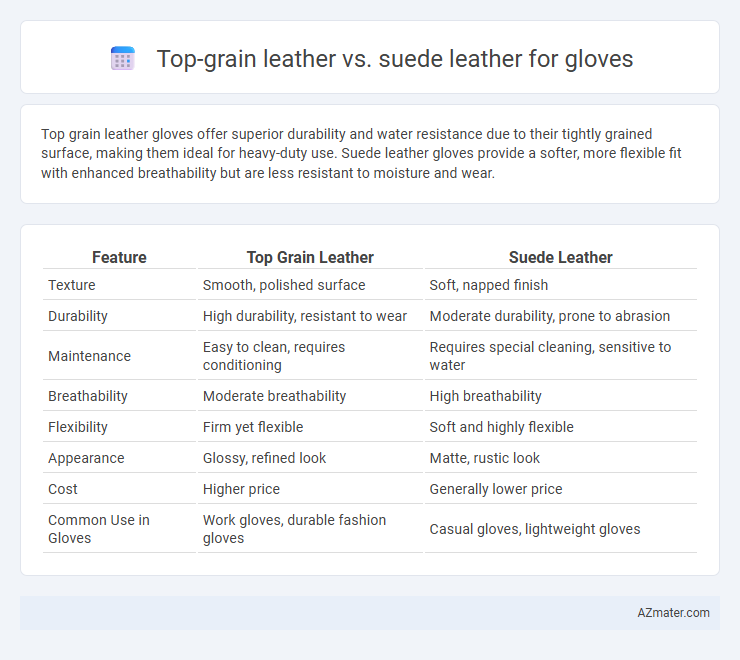Top grain leather gloves offer superior durability and water resistance due to their tightly grained surface, making them ideal for heavy-duty use. Suede leather gloves provide a softer, more flexible fit with enhanced breathability but are less resistant to moisture and wear.
Table of Comparison
| Feature | Top Grain Leather | Suede Leather |
|---|---|---|
| Texture | Smooth, polished surface | Soft, napped finish |
| Durability | High durability, resistant to wear | Moderate durability, prone to abrasion |
| Maintenance | Easy to clean, requires conditioning | Requires special cleaning, sensitive to water |
| Breathability | Moderate breathability | High breathability |
| Flexibility | Firm yet flexible | Soft and highly flexible |
| Appearance | Glossy, refined look | Matte, rustic look |
| Cost | Higher price | Generally lower price |
| Common Use in Gloves | Work gloves, durable fashion gloves | Casual gloves, lightweight gloves |
Introduction to Top Grain Leather and Suede Leather
Top grain leather is crafted from the upper layer of the hide, providing durability, smooth texture, and resistance to wear, making it ideal for high-quality gloves requiring longevity and a refined appearance. Suede leather, derived from the underside of the hide, features a soft, fuzzy surface that offers flexibility and a distinct tactile feel but is more susceptible to stains and wear. Selecting between top grain leather and suede for gloves depends on the balance between durability, style, and maintenance preferences.
How Top Grain Leather is Made
Top grain leather for gloves is made by splitting the top layer of animal hide, sanding it lightly to remove imperfections, and then applying a protective finish that enhances durability and water resistance. This process preserves the natural grain, resulting in a smooth, strong surface ideal for premium glove performance. In contrast, suede leather, derived from the underside of the hide, offers a softer texture but lacks the robustness and protective qualities of top grain leather.
The Suede Leather Production Process
Suede leather gloves are produced by sanding or buffing the inner split of the hide, creating a soft, napped surface that enhances grip and comfort. This intricate production process involves carefully separating the top grain from the lower layers, which distinguishes suede from the smoother top grain leather commonly used in more durable glove designs. The porous nature of suede leather, resulting from its unique processing method, offers breathability but requires more delicate care compared to the tougher, more water-resistant top grain leather gloves.
Texture and Feel: Comparing Top Grain vs. Suede
Top grain leather gloves feature a smooth, durable surface with a slightly glossy finish, offering a firm and structured feel ideal for heavy-duty use. Suede leather gloves showcase a soft, velvety texture with a matte appearance, providing exceptional comfort and flexibility but less resistance to wear. The tactile contrast between top grain's polished texture and suede's plush nap significantly influences grip and breathability in glove performance.
Durability and Longevity: Which Glove Lasts Longer?
Top grain leather gloves offer superior durability and longevity due to their dense fiber structure and resistance to wear and tear, making them ideal for heavy-duty use. Suede leather gloves, while softer and more flexible, tend to wear out faster because of their open fiber texture, which is more susceptible to abrasion and environmental damage. Choosing top grain leather gloves ensures a longer lifespan and better protection for demanding tasks.
Comfort and Flexibility for Glove Wearers
Top grain leather offers superior durability and breathability, making gloves comfortable for prolonged use by maintaining natural hand temperature. Suede leather provides enhanced flexibility and a softer texture, allowing for greater dexterity and ease of movement in gloves. While top grain leather excels in strength and moisture resistance, suede delivers unmatched comfort through its supple feel, ideal for precision tasks demanding tactile sensitivity.
Appearance and Style Differences
Top grain leather gloves feature a smooth, polished surface with a slightly glossy finish, offering a sleek and refined appearance ideal for formal wear. Suede leather gloves have a soft, napped texture with a matte finish, creating a casual and vintage-inspired style perfect for relaxed or rustic looks. The distinct tactile qualities and sheen differences make top grain leather gloves more durable and elegant, while suede gloves emphasize comfort and a rugged charm.
Maintenance and Cleaning Requirements
Top grain leather gloves require simple maintenance with regular wiping using a damp cloth and occasional conditioning to preserve suppleness and resist moisture. Suede leather gloves demand more careful upkeep, including brushing with a soft suede brush to remove dirt and using specialized suede cleaners to prevent staining and water damage. Both types benefit from storing in a cool, dry place to maintain texture and durability.
Cost Differences: Top Grain vs. Suede Gloves
Top grain leather gloves generally cost more due to their durability, smooth finish, and higher-quality tanning process compared to suede gloves. Suede gloves are typically more affordable as they utilize the underside of the hide, resulting in a softer texture but lower resistance to wear and tear. The price difference reflects top grain's premium strength and polished appearance versus suede's comfort and casual style.
Which Leather is Best for Your Glove?
Top grain leather offers superior durability and water resistance, making it ideal for gloves subjected to heavy use and outdoor conditions. Suede leather provides a softer, more flexible feel with enhanced breathability, suited for light-duty gloves where comfort and dexterity are prioritized. Choosing between top grain and suede leather depends on your glove's intended use, with top grain excelling in toughness and suede excelling in comfort.

Infographic: Top grain leather vs Suede leather for Glove
 azmater.com
azmater.com